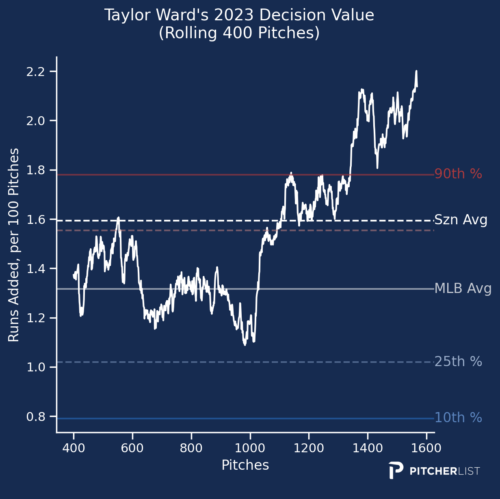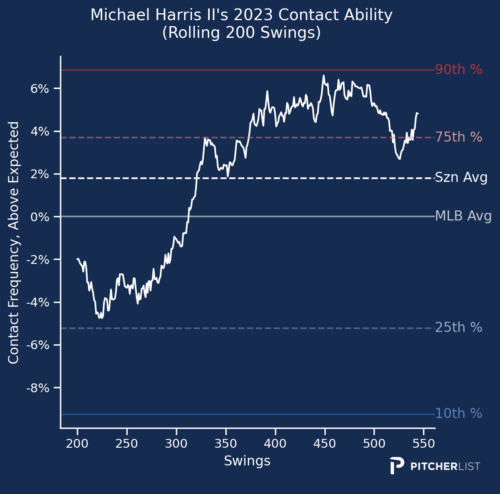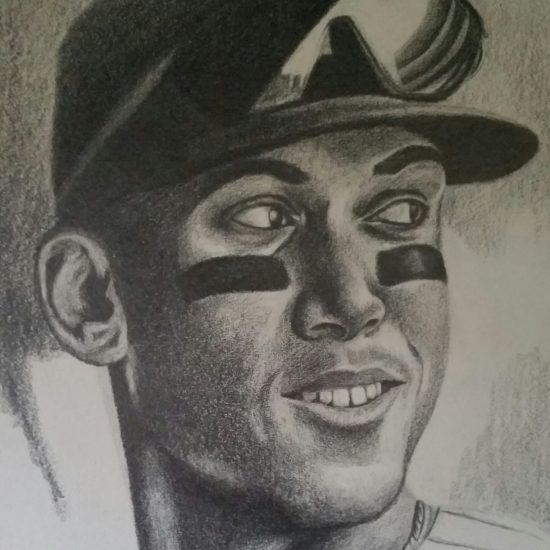This past offseason, Pitcher List introduced Pitch Level Value, or PLV, a new metric that assesses player performance by grading outcomes on the single pitch level. If you’re new to it, you can read Nick Pollack’s primer on PLV here.
You’ll find the definitions below. Grades are on a 20-80 scale.
Swing Aggression: How much more often a hitter swings at pitches, given the swing likelihoods of the pitches they face.
Strikezone Judgement: The “correctness” of a hitter’s swings and takes, using the likelihood of a pitch being a called strike (for swings) or a ball/HBP (for takes).
Decision Value (DV): Modeled value (runs per 100 pitches) of a hitter’s decision to swing or take, minus the modeled value of the alternative.
Contact Ability: A hitter’s ability to make contact (foul strike or BIP), above the contact expectation for each pitch.
Power: Modeled number of extra bases (xISO on contact) above a pitch’s expectation, for each BBE.
Hitter Performance (HP): Runs added per 100 pitches seen by the hitter (including swing/take decisions), after accounting for pitch quality.
Pitch Level Value (PLV): Estimated value of all pitches, based on the predicted outcome of those pitches (0-10, 5 is league average).
Pitch Level Average (PLA): Value of all pitches (ERA Scale), using IP and the total predicted run value of pitches thrown.
Pitch type PLA: Value of a given pitch type (ERA scale), using total predicted run values and an IP proxy for that pitch type (pitch usage % x Total IP).
(Note: All PLV data is current through Thursday, 7/27).
Looks can be deceiving. By looks, I mean Zack Wheeler’s 3.88 ERA and 1.14 WHIP. Of course, those ratios are nothing to sneeze at but his PLV numbers indicate that he’s been ever better. Of all pitchers with at least 1,500 pitches this season, Wheeler is first in PLV.
Overall, Wheeler’s heater has been phenomenal with a 2.42 PLA, second only to Spencer Strider’s 2.18 (1,500 pitches minimum).
He’s racked up some impressive performances lately, too. Last Saturday, the former Met held the Guardians to one earned run on five hits over seven innings that resulted in a 5.54 PLV (109 pitches). Note that 5.50 is considered a quality pitch, so that’s an excellent score for an outing.
His start against the Marlins on July 7th was even better: a 5.83 PLV (101 pitches). His fastball during that start (45 pitches) earned a ridiculous 6.10 PLV / 0.75 PLA. And yet the results didn’t quite match: three earned runs on seven hits over six innings of work. That very much feels like a microcosm of Wheeler’s season. The overall results have been very good, but everything else says indicates another gear to be had.
There too is the fact that he came into the year boasting a 2.82 ERA and 1.04 WHIP over his previous three seasons (437.1 IP). As the old saying goes, players tend to perform like the back of their baseball card. Sure enough, Wheeler’s 2.79 PLA, if it were capable of doing so, would be nodding its head in blissful agreeance. All this is to say that Wheeler is very much pitching like one of the best in baseball, so a second-half surge from him would not be the least bit surprising.
He was up to his usual shenanigans on Thursday which included his first complete game shutout followed by two dingers in the second game. Ohtani is, of course, one of just six players with 80-grade power (500 pitches minimum). The others are Joey Gallo, Max Muncy, Jack Suwinski, Patrick Wisdom, and Aaron Judge.
His CGSHO earned a 5.25 PLV. I know what you might be thinking; That doesn’t seem that great. You’re right, it’s not. Oddly enough, his previous start against the Pirates, the one in which he surrendered four home runs, earned a better grade. Regardless, Ohtani’s slider continues to lead his arsenal with a 5.54 PLV / 2.21 PLA. His fastball, on the other hand, has been comparatively mediocre with a 4.95 PLV / 3.88 PLA.
A former top prospect who had been derailed by injuries, Kirilloff has made some noise of late with four home runs and a 1.086 OPS over his last ten games. I’ve fallen head over heels for post-hype prospects in the past but in this case, I’m conflicted. I want to be excited but Kirilloff’s profile, so far at least, seems a little bland: above-average contact ability (55), average decision value (50), and average power (50). As far as swing aggression goes, he has been pretty average there too at 0.5%. He has graded out well so far in hit performance (60), so there’s that at least.
Last year in 45 games, he only managed a .361 SLG with PLV giving him the same power grade of 50. It certainly wouldn’t be the first time I looked like an idiot, nor the last since we’ve got two months to go, but I don’t think there’s something can’t miss here.
Casas is a different story. Red Sox fans have to be thrilled. He’s showcased excellent decision value (60) and power (65). The only blemish is below-average contact ability (45). In 17 games in July, he’s hitting a lusty .365 with a 1.284 OPS and the PLV machine is loving every bit of it.

Kim has excelled over the last month (22 games) with a 1.081 OPS. He’s walking noticeably more this year (12.1%) as opposed to last year (8.8%) which is reflected by a -13.9% swing aggression, the lowest among all hitters (minimum 500 pitches). In other words, he doesn’t swing nearly as often as you’d expect when considering the pitch. Lars Nootbaar is the closest at -12.8%. Regardless, Kim’s approach has panned out to the tune of a .365 OBP making him a staple at the top of the Padres lineup. Otherwise, he’s shown the same amount of power this year compared to last (45) with a small dip in contact ability (60 to 55).
Moniak, who committed to UCLA before the Phillies took him first overall in 2016, has been a big reason why the Angels have stayed in the hunt with a .944 OPS over his last 20 games. The power is legit (65). But he swings at everything reflected by an absolutely wild chase rate of 47.6%. Another way to look at it: his swing aggression of 14.6% trails only Yainer Diaz (15%) for the highest among any player (500 pitches minimum). In essence, he’s the anti-Kim. This feels like the sort of approach that should bottom out quickly, especially considering his strikeout problem (35 contact ability).
Speaking of Angels outfielders, Taylor Ward has been making good choices, very good choices.

He’s been an unsung fantasy hero on a Nationals team that’s, well, in Washington, we’ll leave it at that. Last year he hit .241 with a .705 OPS. This year, he’s hitting .290 with a .820 OPS. So what’s been the difference? Not much. Actually, his decision value has dropped from 55 to 50. Otherwise, he’s shown the same league-average grades in contact ability and power. This just seems like a case of the results being drastically different reflected by a 60 in Hitter performance as opposed to 50 last year.
The Twins’ rookie lefty second baseman has a 1.229 OPS with three home runs over his last 12 games. Yes, he has shown power in the minors with a .490 SLG across 113 games in Double-A Wichita last season followed by a .496 SLG in 38 games at Triple-A St. Paul this year.
Otherwise, his walk rates are what really stand out: 18.8% this year in Triple-A. Sure enough, he’s earned a 65 in DV and a 60 in SZ Judgement, so the plate discipline is exemplary. However, it comes with perilously low contact ability (35) amplifying the risk that he might bottom out. Still, the power is legit (60). And the Twins have toyed with the idea of having Jorge Polanco play some third base, giving you an idea that they want to give Julien a long look. His value seems especially contingent on your settings: In standard 5×5, he might be a batting average sink but in OBP or anything with walks, he seems like a good get.
De La Cruz has struggled with strikeouts a bit (32.6%) and that’s at least partly a reflection of him expanding the zone too often (35 SZ Judgement and 30 DV). Of course, that’s not surprising at all and just illustrates the perils of being a 21-year-old rookie. It’s hard to say what to expect from him for the rest of the year. The range of outcomes seems almost infinite. If a time traveler were to tell me what he slashed this season, I’d take their word without asking for verification.
Regardless, I think the fact that he’s already shown league-average contact (50) and power (50) bodes really well for his long-term outlook.
LeMahieu’s strikeout rate was up noticeably earlier in the year. But sure enough, it’s on the way down. Small sample size caveat aside, so far in the second half (11 games), he’s striking out at 15.9% as opposed to 23.3% in the first half. He recently mentioned making some adjustments, so maybe that’s paying off.

Speaking of strikeouts, last year’s N.L. RoY has quietly, after a very slow start to the season, slashed his K rate by nearly five points.

Rookie Starting Pitchers
We’ll end this week by peeking at the top five rookie pitchers by PLV (minimum 500 pitches).
Ryne Nelson is sixth at 5.17. In case you’re wondering about Andrew Abbott and his 1.90 ERA and 0.96 WHIP, he’d be way down on the list at 5.04. The PLV machine doesn’t seem to like his fastball pegging it with a below-average 4.86 PLV / 4.15 PLA.

